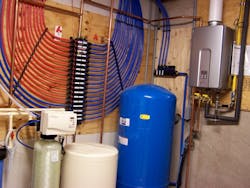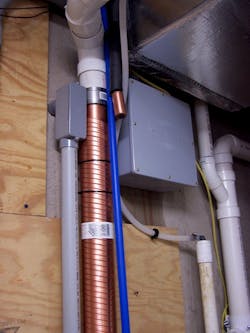Double-walled heat exchanger reduces household water heating costs by up to 40%
MOUNTAIN TOP, PA. — George Hayden Jr. lives with his wife and four young children in a 4,200-sq.ft., two-story craftsman traditional house near Mountain Top, Pa., in a new development. While it may look similar to neighboring houses on the outside, a few things about the plumbing and water systems inside make it unique.
“This house was done as energy-efficiently as we could within limits,” Hayden said. “This becomes evident when you venture downstairs into the mechanical area. Here an energy-saving device known as a Power-Pipe made by RenewABILITY Energy works in conjunction with a Rinnai Hot Way natural-gas-fired on-demand water heater.
“This with that makes a big difference,” Hayden said as he pointed to the Rinnai water heater and then the Power-Pipe.
Hayden built his new house in 2010 to accommodate his growing family and wanted to be as sustainable as possible. The home has four bathrooms, three tied into the Power-Pipe in a three-inch drain line downstairs. In keeping with the theme, Hayden has also added a 10-kilowatt solar photovoltaic system to the house.
Paul Owens of Paul Owens Plumbing & Heating in Plymouth, Pa.,did the plumbing in the house, including the installation of the Power-Pipe. Made of copper, the Power-Pipe DWHR system is a double-walled heat exchanger that recovers heat energy from the wastewater flowing down a household drain and uses it to warm incoming cold water. Multiple coils of rectangular copper tube wrap together in parallel around a central copper drainpipe. Hot water flowing down the drain transfers its heat to incoming cold water moving up the coils in a counterflow mode. Having multiple coils allows for adequate flow with no discernible water pressure loss.
The preferred configuration for providing maximum energy savings plumbs the home's main water line through the Power-Pipe. A second option is to plumb cold water through the Power-Pipe to the water heater only. A third configuration consists of running cold water through the Power-Pipe to the cold side of the shower fixture only.
“We took the well water coming into the house, the main water supply, and then went through the coil and then hooked back into the domestic water,” explained Owens. “We had the showers isolated and brought them down separately, and I piped the shower units, sinks, etc., through that unit. Basically, by using that coil, it up-tempers the water, so it saves you money by not putting ice-cold water through the on-demand water heater.”
Regarding installing the Rinnai tankless water heater, Owens said that the installation is pretty straightforward, and they work really well.
“I do mostly new home construction, and for all the builders I work for, that’s pretty much all we use any more,” said Owens. “Conventional water heaters are soon to be obsolete, I believe. The on-demand efficiency is way better. Why heat water you don’t have to heat?”
In their previous house in Hazleton, Pa., the Haydens had a traditional electric tank water heater and two showers. Their gas bill runs about $60-70 a month now compared to an electric bill of roughly $100 a month before.
RenewABILITY Energy claims that using a Power-Pipe can raise incoming supply water temperature from 50°F to 77°F and reduce overall household water heating costs by up to 40% with a payback of 2 to 6 years.
Hayden discovered the Power-Pipe when RenewABILITY Energy rented space in a building in Hazleton that George J. Hayden Electric-Communications worked on. The company has its U.S. office there.
It’s not surprising that Hayden would want to build an energy-efficient home, considering his company’s direction in recent years. Started in 1975 as an electrical contracting company by his father, the firm has gotten into renewable energy, mainly installing solar PV panels and maintaining the electrical components of nearby wind farms such as substations and transformers.
Based in Milton, Pa., Tom Gibson, P.E. is a consulting mechanical engineer specializing in green building and a freelance writer specializing in engineering, technology, and sustainability. He publishes Progressive Engineer, an online magazine and information source. He can be contacted at [email protected], and for more information, visit www.ProgressiveEngineer.com/consulting.html.



